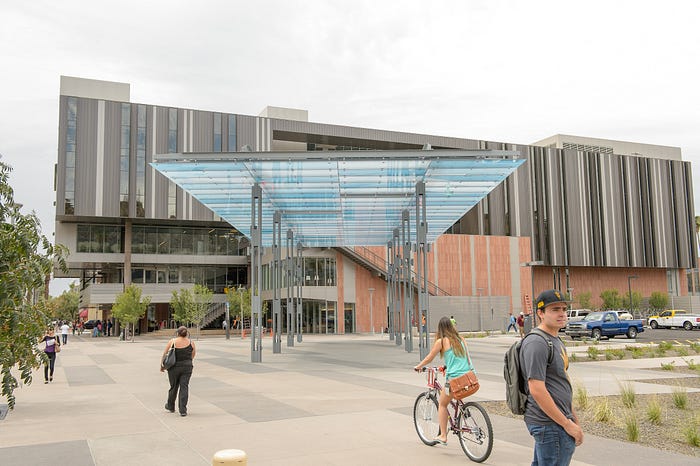7 places to visit on ASU Tempe campus
These campus sites are must-sees.
The historic ASU Tempe campus is home to the College of Liberal Arts and Sciences, the Herberger Institute for Design and the Arts, the School for the Future of Innovation in Society, and the School of Sustainability. Colleges that began on the Tempe campus and have expanded to other campuses are the Ira A. Fulton Schools of Engineering, Mary Lou Fulton Teachers College, the W. P. Carey School of Business, University College and Barrett, The Honors College.
Research entities headquartered on the Tempe campus and integrated throughout the ASU knowledge enterprise include the Biodesign Institute, the Julie Ann Wrigley Global Institute of Sustainability and the Institute for the Science of Teaching and Learning.
The energetic environment of the campus features broad pedestrian malls and eclectic architecture set amid subtropical landscaping. Landmarks include the iconic, century-old Palm Walk; Old Main, the oldest original campus building; Sun Devil Stadium and ASU’s other Pac-12 athletic venues; and the Frank Lloyd Wright-designed Gammage Auditorium. With an unrivaled commitment to sustainability, the Tempe campus is the most solar powered of any in the U.S. and offers easy access to all of metropolitan Phoenix through public transit including light rail.
With so many options, visiting ASU’s Tempe campus can seem pretty daunting — it really isn’t! With so many beautiful spots on the Tempe campus, we’ve collected a few favorites for you and family or friends to go check out.
Future Sun Devil Welcome Center and College Avenue Commons

This building is a mixed-use facility including the Future Sun Devil Welcome Center, the ASU School of Sustainable Engineering and the Built Environment and the Sun Devil Marketplace. The facility provides mediated classrooms, offices, labs and collaboration and study spaces for Del E. Webb School of Construction, Construction Engineering, the Alliance for Construction Excellence and the Civil, Environmental and Sustainable Engineering Department. The building also features a Tech Studio location, which provides tech support for computer problems.
Stroll down College Avenue and check out the restaurants as well as our biggest bookstore containing apparel, ASU memorabilia and so much more. The best part, ‘A’ Mountain is at the end of College Avenue so you can admire it or enjoy the hike and the views!
Gammage Auditorium

For more than 50 years, ASU Gammage has been the heart of the arts in the Valley of the Sun and the crowning jewel of ASU’s Tempe campus. The last work of great architect Frank Lloyd Wright, ASU Gammage is the largest college presenting organization in the country, featuring one of the top Broadway series in the nation. ASU Gammage is also the location for many university traditions and special graduation celebrations at the close of each semester.
Constructed in 1964, the building is named for Grady Gammage, the legendary ASU president who led Arizona State College’s victorious campaign in the state legislature for a name change to Arizona State University in 1958.
If you are staying in Tempe long enough, seeing a show is always a great experience! Check out showtimes on the auditorium’s website. Even if you don’t have time to see a show, taking a stroll around the greenery and the fountains that surround Gammage is the perfect way to see the gorgeous structure of the building. Recently, USA Today listed six of the nation’s top “have-to-see” college campus buildings reflecting mid-century modernism, including ASU Gammage.
Says USA Today of ASU Gammage:“Versatility is its most valuable trait — the auditorium has successfully hosted both rock stars like Bruce Springsteen and symphonies by the Philadelphia Orchestra over its 53-year history.”
ASU Student Pavilion

Located in the center of student life at ASU’s Tempe campus, the new Student Pavilion is a multi-use event space for guest lectures, musicals, comedic performances and student productions, with auditorium-style seating for 1,200. The second floor houses office space for student government and student organizations, while university classrooms and other academic functions are located on the third floor
The 74,653-square-foot Student Pavilion is a student-centric facility managed and operated by students with Memorial Union resident staff oversight.
The center was designed as a Net Zero Energy building and will deliver green qualities including renewable energy, energy-efficiency and Zero Waste.
General building hours:
7 a.m. — 10:30 p.m. Monday through Friday and 11 a.m. — 6 p.m. on Saturday and Sunday unless there is a scheduled event.
ASU Art Museum

ASU Art Museum’s mission is to be a meeting point for the exchange of new ideas, perspectives and experiences among artists, students and the public through exhibitions, residencies, collections and programs. The museum forges meaningful connections across all areas of research in order to create a better, more sustainable future.
ASU Art Museum is located in the Nelson Fine Arts Center on ASU’s Tempe campus. The recipient of the 1989 American Institute of Architects Award, the Nelson Fine Arts Center was designed by Albuquerque-based architect Antione Predock and also houses dance and theatre labs and studios as well as the Galvin Playhouse. Described as a “magic mountain” and an “oasis,” the design draws from the history of desert architecture to respond to the environment and climate of the site. The museum facility itself features three floors of year-round exhibitions that rotate seasonally and an award-winning store.
Regular hours:
Tuesday–Saturday 11 a.m.–5 p.m.
Thursday 11 a.m.–8 p.m. during academic semesters
Closed Sunday, Monday and university holidays
Additional educator hours are available by appointment: Mondays and before 11 a.m. Tuesday–Thursday.
Palm Walk

Palm Walk is a popular corridor among students, faculty, staff and university visitors alike. Palm Walk is the most photographed site on the Tempe campus and extends from the University Bridge in the north to the Sun Devil Fitness Complex in the south.
Old Main

Constructed before Arizona achieved statehood, Old Main represents a rich tradition for Arizona State University and the state. Old Main has been refurbished to period standards and is listed on the National Register of Historic Places. It is now home to the ASU Alumni Association.
Originally dedicated Feb. 4, 1898, it was the first building in Tempe wired for electric lighting. President Teddy Roosevelt dedicated the Roosevelt Dam from the front stairway in 1911.
“A” Mountain
The Tempe Normal School class of 1918 was responsible for installing the first letter on Tempe Butte. When the school changed its name to Tempe State Teachers College in 1925, students retained one side of the “N” to form the stem of the “T.”
The school changed its name to Arizona State Teachers College, and in 1938, the letter “A” was installed on the butte. The present “A” stands 60 feet tall and was built of reinforced steel and concrete in 1955.
Guarding the “A”
Each year, during the week leading up to the ASU vs. University of Arizona football game, the Student Alumni Association coordinates the guarding of our beloved gold “A” from being painted by U of A students.
Bonus:
Academic buildings

ASU offers outstanding resources for study and research, including libraries with holdings that rank in the top 20 among public institutions, studios and performing arts spaces for creative endeavors and unsurpassed state-of-the-art scientific and technological laboratories and research facilities. The Tempe campus is home to buildings on the National Historic Register and those certified through the U.S. Green Building Council’s Leadership in Energy and Environmental Design (LEED) Green Building Rating System.
Whether you are an alum looking to relive your time on campus, or a parent interested in where your child has spent the last four years, a tour of these buildings is a must. For a complete list of academic buildings, click here.
Research buildings

ASU has created new kinds of university spaces that promote academic partnerships with the community, industry and government, which enables us to take on the economic, social and cultural challenges facing our society. Undergraduate students are actively involved in research opportunities that complement their classroom experiences.
ASU students, scholars and partners operate in a rich new educational environment — one that is interdisciplinary, creative and hyper-connected to community trends and needs. All new buildings at the university are designed for certification through the U.S. Green Building Council’s Leadership in Energy and Environmental Design (LEED) Green Building Rating System™.
For a complete list of research buildings, click here.
Fine Art buildings

ASU is privileged to provide students, faculty and the general public with access to world-class fine art venues and experiences. ASU Gammage, designed by internationally renown architect Frank Lloyd Wright, is one of the busiest university-based performing arts venues in the world.
Separate, dedicated buildings are provided for ASU students studying studio art, ceramics, music, dance, lyric opera, theater and film. The Herberger Institute for Design and the Arts supports several venues across campus, including the Evelyn Smith Music Theatre, Katzin Concert Hall, Paul V. Galvin Playhouse, Lyceum Theatre, Nelson Fine Arts Center, Prism Theatre and the Organ Hall. The ASU Herberger Institute School of Art is one of the largest art schools in the country and has extensive facilities, including four galleries — Harry Wood, Northlight, Step and Gallery 100 — devoted almost entirely to the exhibition of student work.
For a complete list of fine arts buildings, click here.
Watch the video below and experience life at ASU’s Tempe campus:
Want to learn more about ASU’s Tempe campus? Schedule a tour here!
